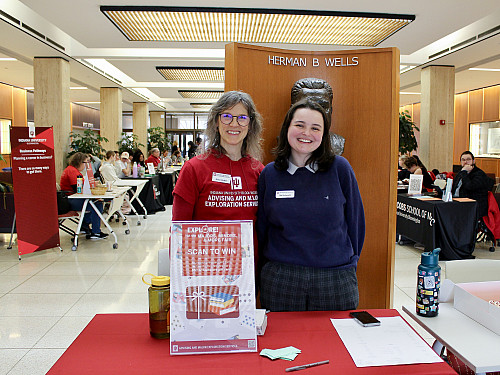Undergraduate advising redesigned: Changes starting to have a positive impact
By Kirk Johannesen
June 02, 2025
Changes to the academic advising model at Indiana University Bloomington that are designed to provide students with a holistic experience and support success are part of a series of initiatives that are starting to improve retention and DFW rates.
The university wanted advising to be a more prominent part of the student experience, and the Academic Advising 2030 Implementation Workgroup made multiple recommendations:
- Academic advising should be holistic, not just helping with courses but understanding students and their needs.
- Academic advising should be expected and required.
- The ratio of advisors to students should decrease.
- The minimum salary of advisors should be raised.
“The reason is that academic advising has a high impact,” Vice Provost for Undergraduate Education Vasti Torres said. “If you receive good advising, you are more likely to stay on track and more likely to graduate.”

Positive results are starting to show.
The fall 2022 retention rate was 90%, and it was 90.1% for fall 2023. Combined with efforts by the Center for Innovative Teaching and Learning Crimson Course Transformation, the rate of students receiving grades of D or F or withdrawing from a class fell to 7% for fall 2024 from 8.1% in fall 2023.
“The most important thing is that all of these pieces are integrated to help students,” Torres said.
One of the most notable changes was the transition from University Division to Advising and Major Exploration Services, which began in summer 2024 to help pre-business, pre-nursing and declared exploratory students.
“Some students come here and don’t know what they want to do; they can go to AMES,” Félix-Brasdefer said. “The goal is to help them find what they are interested in and a pathway.”
University Division used to help all pre-majors. However, the gradual change of direct admission to schools, and more students wanting direct admission to their major, changed University Division’s focus, Torres said. Advising for most pre-majors shifted directly to the schools, and the division’s name was changed to Advising and Major Exploration Services to accurately reflect the services offered.
Advising and Major Exploration Services has a team of 21 academic advisors and 15 peer academic coaches to help students. When possible, students are assigned to the academic advisors they met with during new student orientation, and they work with that advisor their first year, Advising and Major Exploration Services Director Daniel Lersch said. The goal is to work with students on understanding and completing the requirements needed to gain admission to their school, and help exploratory students figure out a major to pursue.
Advisors for Advising and Major Exploration Services are generalists who know the requirements for all majors, Lersch added. They help students with parallel planning for majors to provide an alternate academic pathway in case students aren’t admitted into their preferred school, or if they switch majors or transfer from another university.
“I think what has been successful is creating a space for students who are pursuing a limited-capacity program to develop a holistic plan,” Lersch said. “Some students may not get into their first major of choice, so we help them understand all options available to them and how to pursue parallel educational pathways.”
Torres said that undergraduate deans agreed to use common language and criteria for determining a student’s academic standing so it’s clear to everyone when a student switches majors and advisors.
Another change is the requirement for students to meet with their academic advisors at least once each semester, Torres said. Previously, some students never met with an advisor after new-student orientation.
“The students who needed the most help with academic advising often were the least likely to get it,” Torres said. “They may not have realized what an academic advisor does or how to get help. They may have worked and thought they didn’t have the extra time.”
Also, nine additional academic advisors were hired, which lowered the student-to-advisor ratio from 400-to-1 in some cases to 275-to-1 and brought it closer to the recommended ratio of 250-to-1 suggested in the Boyer 2030 Commission report “The Equity-Excellence Imperative” about undergraduate education at U.S. research universities.
The minimum salary of advisors was increased as well.
“Salaries for academic advisors varied greatly, making it attractive to go from unit to unit for higher pay,” Torres said. “The increase in salary provided more stability across academic units.”
With these changes in academic advising, Félix-Brasdefer said, IU Bloomington is committed to the IU 2030 strategic plan to foster student success through “access to career preparation and academic advising for all IU students, including the significant expansion of high-impact experiential and career-related student experiences.”